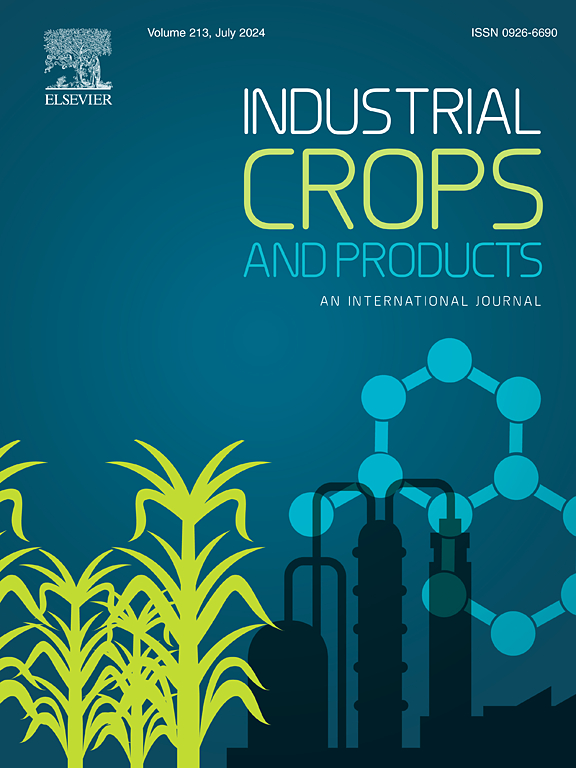Changes in morpho-physiological traits and phytochemical composition of Cannabis sativa L. treated with microbial biostimulants across different substrates
IF 5.6
1区 农林科学
Q1 AGRICULTURAL ENGINEERING
引用次数: 0
Abstract
Cannabis is a versatile crop with multiple uses, making its production highly significant. Its growth is influenced by various factors, including growing medium. Beneficial microbes, as a sustainable approach, can impact plant growth, but their effects on cannabis’ chemical profile are not well understood. This study examined two substrates (pure coco fibre and potting soil containing Sphagnum peat moss and perlite) and a microbial biostimulant comprising five Bacillus strains (two B. velezensis, two B. megaterium, and one B. licheniformis) on cannabis growth and secondary metabolites across all growth stages. The results show that biostimulant inoculation increased flower yield by 16 % in coco fiber and 12 % in potting soil compared to uninoculated controls. It also enhanced CBDA (cannabidiolic acid) and THCA (tetrahydrocannabinolic acid) concentrations by 5 % and 10 % in coco fibre and potting soil, respectively. Biostimulant-treated plants showed a 5 % increase in total terpene levels in coco fibre but not in potting soil. Regarding growing medium, cannabis grown in potting soil showed greater overall biomass accumulation (leaf, stem, and flower) and higher leaf chlorophyll concentrations during both vegetative and reproductive stages. In contrast, coco fiber promoted root growth during the vegetative stage and resulted in significantly higher cannabinoid and terpene concentrations at maturity. Hence, coco fibre may be advantageous for enhancing cannabinoid and terpenoid profiles, while potting soil is better suited for maximizing plant yield, depending on the desired production goals. These findings emphasize the critical influence of substrate type and biostimulant application, and their interaction, in optimizing cannabis cultivation practices.
不同基质下微生物刺激素处理对大麻形态生理性状和植物化学成分的影响
大麻是一种用途广泛的作物,其生产意义重大。其生长受到包括生长介质在内的各种因素的影响。有益微生物作为一种可持续的方法,可以影响植物的生长,但它们对大麻化学成分的影响尚不十分清楚。本研究考察了两种基质(纯椰子纤维和含有泥炭藓和珍珠岩的盆栽土壤)和由五种芽孢杆菌菌株(两种 B.velezensis、两种 B.megaterium、一种 B.licheniformis)组成的微生物生物刺激剂对大麻生长和各生长阶段次生代谢物的影响。结果表明,与未接种生物刺激剂的对照组相比,接种生物刺激剂可使可可纤维和盆栽土壤中的鲜花产量分别提高 16% 和 12%。生物刺激剂还能提高可可纤维和盆栽土壤中的 CBDA(大麻二酚酸)和 THCA(四氢大麻酚酸)浓度,增幅分别为 5% 和 10%。经生物刺激剂处理的植物在椰子纤维中的萜烯总含量增加了 5%,但在盆栽土壤中却没有增加。在生长介质方面,盆栽土壤中生长的大麻在无性和生殖阶段的总体生物量积累(叶、茎和花)更多,叶片叶绿素浓度更高。相比之下,椰果纤维在无性繁殖阶段能促进根系生长,成熟时大麻素和萜烯的浓度明显更高。因此,可可纤维可能有利于提高大麻素和萜类化合物的含量,而盆栽土壤则更适合最大限度地提高植物产量,具体取决于预期的生产目标。这些发现强调了基质类型和生物刺激剂的应用及其相互作用对优化大麻种植方法的重要影响。
本文章由计算机程序翻译,如有差异,请以英文原文为准。
求助全文
约1分钟内获得全文
求助全文
来源期刊

Industrial Crops and Products
农林科学-农业工程
CiteScore
9.50
自引率
8.50%
发文量
1518
审稿时长
43 days
期刊介绍:
Industrial Crops and Products is an International Journal publishing academic and industrial research on industrial (defined as non-food/non-feed) crops and products. Papers concern both crop-oriented and bio-based materials from crops-oriented research, and should be of interest to an international audience, hypothesis driven, and where comparisons are made statistics performed.
 求助内容:
求助内容: 应助结果提醒方式:
应助结果提醒方式:


